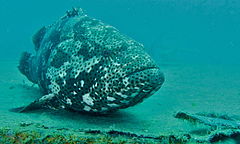|
Malabar grouper
The Malabar grouper (Epinephelus malabaricus) also known as blackspot rockcod, estuary rockcod, giant rock cod, greasy grouper, Malabar rockcod, Morgan's cod or speckled grouper, is a species of marine ray-finned fish, a grouper from the subfamily Epinephelinae which is part of the family Serranidae, which also includes the anthias and sea basses. It is found in the Indo-Pacific region. It has entered the Mediterranean Sea from the Red Sea by way of the Suez Canal as a Lessepsian migrant. Distribution and habitatThe Malabar grouper is widespread throughout the tropical waters of the Indo-West Pacific area from the eastern coast of Africa to the Tonga Islands, Red Sea included.[2][1] It was first recorded in the eastern Mediterranean Sea in 1969 where it remains extremely rare. Mariculture and shipping are possible vectors of introduction.[3] This grouper lives in various habitats, such as lagoons, mangroves, coral and rocky reefs, sandy and muddy bottom areas,[4] between 2 and 150 m deep.[5] The juveniles prefers lagoon or brackish areas.[4] DescriptionThe Malabar grouper can reach a length up to 234 cm (92 in), but average size is usually around 100 cm (39 in).[6] It has a light grey to light brownish background color, with a number of dark brown spots randomly scattered, which increase in number with age. The body has also a various number of brown diagonal stripes. Younger fish have a number of wide, broken vertical bands of darker shade across their bodies, but in maturity they seem to become a uniform darker colour. Young fish have numerous brown spots. The tail fin is rounded.[3] BiologyEpinephelus malabaricus is a protogynous hermaphrodite, as these fishes at some point in their lifespan change sex from female to male.[5] Malabar grouper are voracious predators, they feed on fish, crustaceans, and occasionally, cephalopods.[7] ParasitesAs most fish, the Malabar grouper harbours a variety of parasites, including the diplectanid monogeneans Pseudorhabdosynochus manifestus, P. maaensis, P. malabaricus, P. manipulus, P. marcellus, and P. maternus.[8] UsesMalabar groupers are harvested for food, sport, and commercially; some are grown in aquaculture. Gallery
References
External linksWikimedia Commons has media related to Epinephelus fasciatus. |
||||||||||||||||||||||||||||||||||||||||




